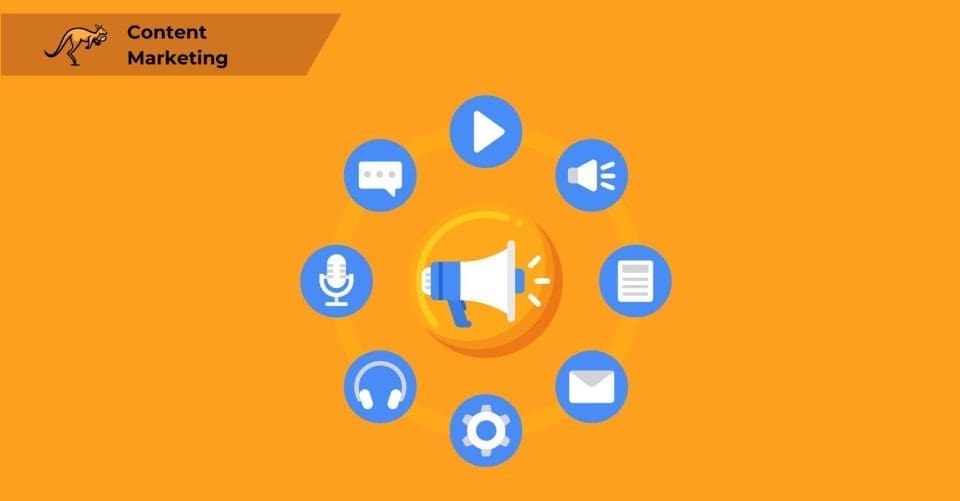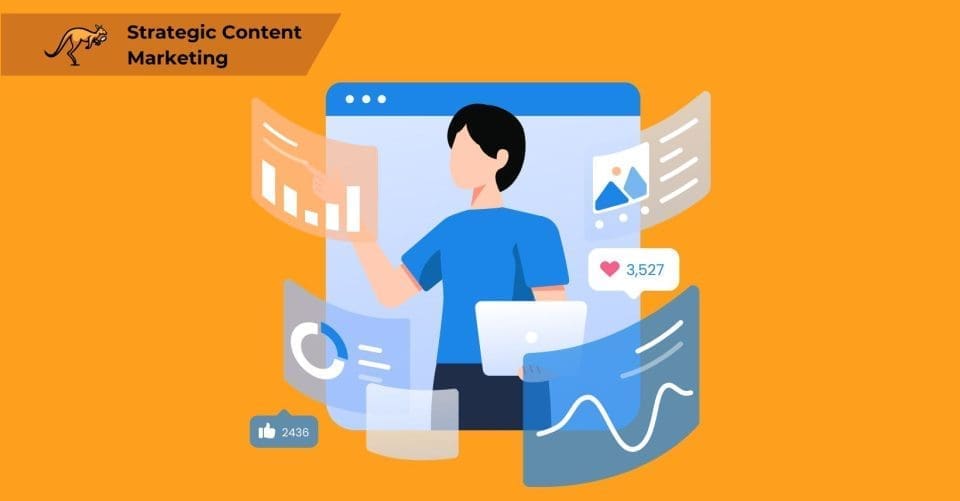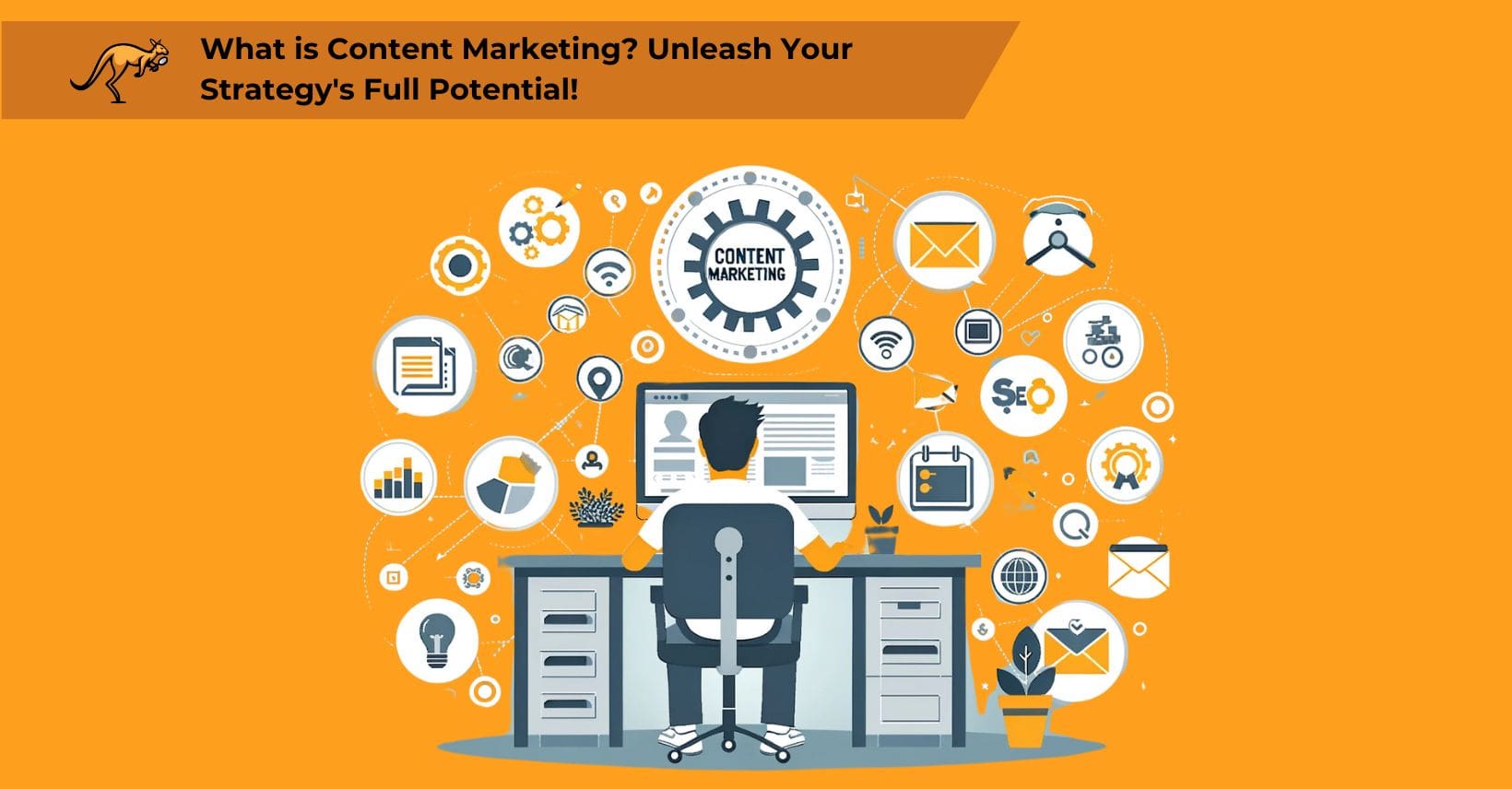Content marketing strategy is a systematic approach centered on creating, optimizing, publishing, and promoting various types of content that aligns with your business goals and audience needs, which serves as a core part of your overall marketing approach.
This includes everything from blog posts and professionally-written articles to video content and ebooks—anything you publish online that isn’t a typical paid ad.
Whether you’re new to content marketing or have been refining your strategy for a while, understanding how to use it effectively is crucial.
An effective content marketing strategy can significantly boost your online presence, while a poor one can hinder your success. To truly grasp its impact, it’s essential to know what content marketing really entails.
What is Content Marketing Overall?

Content marketing involves planning, developing, creating, publishing, sharing, and long-term impact of content.
The goal remains consistent: building brand awareness, engagement, and ideally, sales. The internet is vast, filled with diverse information, and many users seek it.
From social media posts to detailed articles, users search for specific content.
Websites providing this content gain more attention, especially if it meets the needs and wants of potential customers.
This creates a chance to turn potential customers into real ones. A successful content marketing strategy focuses on drawing attention and generating useful traffic, then maximizing these benefits effectively.
To truly excel, one must delve deeper into the nuances of how content marketing functions.
Understanding Content Marketing
Understanding “what is content marketing?” is straightforward, but it doesn’t capture the complexities of a typical content marketing strategy.
Content consists of various individual concepts that each business must handle in a way that suits them specifically.
While offline content marketing like brochures exists, online content marketing has become the standard for most businesses.
But what does content marketing actually entail, especially for businesses just starting their content marketing journey?
Types of Content Marketing
Approaching a content marketing strategy involves selecting the types of content you will use. All content marketing strategies aim to build brand awareness and attract potential customers.
Different businesses may target specific types of content to play to their strengths or capture a particular audience.
Online Content/Website Content
Online content often refers to content on your web pages, such as the home page or product pages. Strong website content is essential for boosting SEO and attracting traffic.
Product pages, FAQ pages, and service descriptions can all be valuable content sources.
Blog Content Marketing
Blog posts are a reliable way to handle content marketing. A blog allows you to create articles focused on relevant content subjects, building links and gaining traction on social media.
Good blog posts can generate more content for your audience with minimal extra effort.
Social Media Content Marketing
Social media is a major part of many content marketing efforts. Platforms like Facebook, Twitter, and Instagram allow you to post short-form content for free and build a dedicated audience.
Social media platforms support various content types, making them invaluable for building awareness.
Podcast Content Marketing
Podcasts are popular and can work well for businesses with a clear audience. They allow for creative marketing strategies, whether funny and engaging or serious and informative.
However, podcasts require more effort and planning to produce quality content.
Video Content Marketing
Videos are one of the most consumed types of content on the internet. With the right setup, video content can effectively engage people and get your message out there.
The challenge with video content is optimizing tags and titles to get the desired traction.
Infographic Content Marketing
Infographics simplify complex topics and can make your brand an authority. They appeal to people who prefer visual references, potentially attracting new customers.
Creating infographics tailored to a specific audience can provide valuable information and secure new clients.
Paid Advertising Content Marketing
Paid ads, including banner ads and sponsored blog posts, are part of content marketing strategies. While there are factors to consider, such as cost and site restrictions, paid ads can guarantee a certain level of brand awareness and engagement.
Now that we’ve covered various types of content marketing, it’s important to see how these pieces come together in a content marketing strategy.
How Does a Content Marketing Strategy Actually Work?
Content marketing strategy works by systematically creating and distributing valuable content that attracts a defined audience, which then builds trust and ultimately drives profitable customer actions.
Providing your audience with valuable information is only part of the equation. The goal is to influence their actions and opinions positively, shaping how they view your business.
Effective content marketing makes users think of your brand favorably, establishing trust. This approach not only increases traffic but also boosts sales and overall success.
There are various strategies in content marketing, all aiming for similar outcomes but with different paths.
As you continue to refine your content strategy, you’ll notice another key benefit that ties into building a stronger connection with your audience.
Building Brand Awareness with Content Marketing
In marketing, brand awareness is crucial. It means making sure people recognize your brand and associate it with your products or services.
Content marketing helps by providing a cost-effective way to reach a wider audience.
Creating blog posts or other content can boost your online presence, whether you promote it on other platforms or use it on your website for better search engine rankings.
Sharing content on social media can attract a lot of attention, drawing in potential customers who learn about your brand, products, and services.
Sometimes, just seeing a headline can start someone on the path to making a purchase.
Now, let’s explore how content marketing can drive sales even further.
Increasing Sales through Content Marketing
Sales are a crucial metric for any business. A good content marketing campaign can boost sales, either directly or indirectly, by creating compelling content that encourages potential customers to view your business positively and choose to spend their money on it.
Effective marketing targets the right places, like promoting products on social media channels, making them appealing. Increased online visibility leads to more sales, as more users are exposed to your site.
Content marketing works best as a lead-generation tool. More leads mean more sales, with great content swaying leads to prefer one brand over another.
Creating good content improves your reputation and brand awareness, influencing purchasing decisions and leading to better business performance.
To make the most of content marketing, it’s important to think about how to use it strategically…
Using Content Marketing Strategically

Sales are a crucial metric for any business. A good content marketing campaign can boost sales, either directly or indirectly, by creating compelling content that encourages potential customers to view your business positively and choose to spend their money on it.
Effective marketing targets the right places, like promoting products on social media channels, making them appealing. Increased online visibility leads to more sales, as more users are exposed to your site.
Content marketing works best as a lead-generation tool. More leads mean more sales, with great content swaying leads to prefer one brand over another.
Creating good content improves your reputation and brand awareness, influencing purchasing decisions and leading to better business performance.
To make the most of content marketing, it’s important to think about how to use it strategically.
Creating a Successful Content Marketing Campaign
Creating a successful content marketing campaign requires identifying your target audience, selecting appropriate content types, establishing clear goals, and developing high-quality content that addresses specific audience needs, which then guides users through their buying journey.
Different platforms, audiences, business niches, and topics require various techniques, making your content marketing campaigns unique to your business.
However, there are common patterns that every marketing team eventually recognizes, forming “general rules” worth following.
When starting out with a content marketing strategy, consider these points:
Find Your Target Audiences
Identify the audiences you want to target before creating content. Most businesses have a clear idea of their audience’s characteristics, but it’s crucial to tailor content to multiple target audiences if you offer various products or services.
Create relevant content to attract and engage your ideal audience by asking key questions: Which products or services are you marketing? Who is likely to buy them? Where do they spend time online? What are their interests? What will naturally lead them to your brand?
Understand How to Target That Audience
Knowing your target audience is essential, but you must also know how to engage them.
Decide whether to use blog posts, social media, or other content types.
Avoid targeting the wrong audience or using the wrong approach for the right audience, which can lead to disengagement.
Ensure your content aligns with your audience’s interests and needs to capture their attention.
Have a Clear Vision for Content Creation
With your audience in mind, develop a clear vision for your content. Understand its purpose and plan the type of content you’ll use.
Effective content provides value, encouraging users to engage with it. High-quality content, such as how-to guides, solves problems and attracts new customers.
Other valuable content includes product breakdowns, review posts, and informative pages on your website.
Use a Mix of Types of Content Marketing
Relying on a single type of content can lead to missed opportunities. Instead, use various content forms, each with its advantages.
Videos capture attention on video-based sites, while blog posts and articles provide valuable resources.
Spread your content across multiple formats to maximize your reach and avoid overlapping content that fails to attract new audiences.
Aim to Become an Industry Leader or Authority
Success in content marketing often comes from becoming a trusted voice in your niche. Create original content that offers value, such as key statistics or reliable information.
Earning your audience’s trust through high-quality, unique content makes your marketing efforts more effective.
Once trusted, your content strategy shifts from convincing to informing your audience about beneficial products or services.
Know Your Goals
Tailor your content marketing strategy to your business goals. Whether focusing on social media marketing, breaking into the podcast market, or using digital marketing tactics, your approach should align with your objectives.
Set long-term and short-term goals, adjusting based on what works best for your content marketing efforts.
By considering these strategies, you’ll be well on your way to understanding the essential components for a successful campaign.
But what exactly do you need to succeed with content marketing?
What Do I Need to Succeed with Content Marketing?
A successful content marketing strategy requires several essential elements including a defined audience, trending topics, understanding of the buyer’s journey, identified pain points, optimized landing pages, consistent scheduling, and strong SEO, which together create a cohesive approach that delivers measurable results.
Effective content marketing involves two key aspects: leveraging expert insights from sources like the Content Marketing Institute and recognizing the numerous factors that can alter your plan.
Starting out, you might have many questions and encounter various challenges in crafting your strategy.
To navigate this, consider these essential points: the importance of content quality, consistency in posting, and knowing your audience.
This brings us to another critical aspect of content strategy that can greatly influence your success.
A Defined Audience
A good content marketing strategy can’t function without a defined audience. This means knowing exactly the kind of users you want to reach, as well as the most effective ways to reach them.
Working out the details behind your audience – like average demographics and common habits – takes some time and careful use of SEO or marketing tools, but the end result is absolutely worth it.
Trending Topics to Target
Knowing your audience is good, but you also want to know what you can target to get their attention.
Tools like Google Trends are invaluable for picking out the latest trends and topics in specific areas or certain audiences so you can quickly adapt your strategy to meet their needs.
An Understanding of The Buyer’s Journey
The Buyer’s Journey is not just a term for the individual journey that your users take but also a defined set of three stages involved in capturing somebody’s interest in a product or service.
In general, users will go through three stages of connection to a product or service that they are being advertised, whether they know they are being marketed to or not:
- Awareness stage: the buyer is experiencing a problem and understands that they need a solution or have a need that they want filled. They are aware that something can probably fix it but do not understand what or where to find it.
- Consideration stage: the buyer now understands more about their issue from the awareness stage and understands the potential solutions. They may also be actively looking at different products or services that could be a potential solution.
- Decision stage: the buyer understands what they want and is making an effort to get it, or at least heavily debating whether or not they want to pull the trigger on a purchase.
They are looking at any trustworthy sources that can offer that particular thing, either to directly buy or to approach for more information.
This applies to all content formats because it does not necessarily have to be tied to a purchase.
For example, users might undergo this journey when looking for a how-to article about something.
This is important to know because different kinds of content might target people in different stages.
Users in the awareness and consideration stages may be more interested in advice and guides, while decision-stage users could be after something closer to a sales pitch.
Identified Pain Points and Interests
Before you create any kind of content, it is important to determine what the audience that you are marketing to actually wants.
Audiences have two main factors to focus on: pain points, which are their problems and frustrations, and their more positive interests.
The customer journey focuses on either resolving one of their pain points, indulging one of their interests, or both.
If you can identify these in your audience, you give yourself a fantastic way to create content that is directly suited to their common wants and needs.
Good Landing Pages
Attracting organic traffic is pointless if they do not actually stay on your site. Landing pages are your first impression to prospective customers, and you want to ensure that it is a good one.
If your landing pages are not properly optimized for a given target audience or simply are not attractive, they can ruin the impression that your company’s brand and website are meant to give.
Having custom landing pages for specific groups of customers or online marketing campaigns is a very common tactic, and it works incredibly well most of the time.
If the first thing a user sees on your site is well-made, relevant content on a fancy landing page, they are much more likely to keep reading.
Good Scheduling
An editorial calendar (a calendar of which content goes out when) can be invaluable for scheduling your content plan.
With a consistent editorial calendar, you can ensure that you always have new content coming out at just the right time to work alongside the others.
This becomes important if you are working across multiple platforms or if your business’ personal content marketing definition begins to get a bit blurred due to focusing on so many niches at once.
Scheduling also makes it easy to avoid stepping on your own toes by posting multiple similar articles at the same time, making them basically redundant.
A Plan for Adaptation
A content marketing plan contains essential components including defined goals, target audience profiles, content types, publishing schedule, distribution channels, and measurement criteria, which together form a roadmap that guides your content creation and marketing efforts.
Content marketing is not just a one-way road, and you want to make sure that you are able to take advantage of opportunities as they arise.
For example, if a major event is happening and you know a lot of users will be interested in the topic, it is probably best to have a few pre-written posts ready to go before the day arrives.
Some of the best content marketers are the ones who can turn an upcoming event by a completely different company or industry into an online marketing opportunity for themselves.
Experience from Existing Customers
It can be difficult to tell what works and what does not when it comes to your business and marketing strategies.
However, if you have some existing customers, you can use them as a baseline for future content marketing efforts.
For example, if your current customer base has a common problem (for example, many of them were past customers looking for last-minute services that other companies do not offer), then creating some content specifically addressing that niche is a good way to get more eyes on the post.
A Brand Image
As strange as it might sound, it is possible to be a company with effectively no brand image.
While you can have a name and a logo, they do not mean much if nobody has ever had a reason to recognize them or if there is not actually any meat behind the brand that you can use in any meaningful way.
Creating a strong brand identity is one of the biggest things you can do to improve your content marketing.
The clearer your brand, the easier it is to create some content around, and the more likely you are to stick in customers’ minds.
For example, look at social media marketing. Would a user actually recognize your site’s brand if they had seen your social media profile in passing?
Probably not, but if you can plant some kind of hook (such as posting regular social media content that might have caught their eye), there is something there to tie the two encounters together in their mind.
Strong SEO
You want people to find your content, and this can be done through a variety of means. However, SEO will always be the easiest and the cheapest way of making yourself more visible.
If you can tweak your site’s existing content (or build more links) to boost your rankings for relevant search results, your site (and accounts on a social media platform, etc.) are more likely to appear for those searches.
The more likely you are to appear for users searching for something related to your business, the more likely you are to capture their interest, so improving your SEO makes a big difference.
A Successful Content Marketing Strategy
Having a strategy that works is essential. Without a clear plan, it’s tough to know if your choices are right. Do you aim to be a niche authority or a business with a strong online presence? What will your content cost, and will it be worth it long-term? While exact answers are hard to predict, a good strategy can give you useful estimates and keep you on track. This helps manage different content formats across various platforms and websites.
Content marketing success is measured through specific metrics including website traffic, engagement rates, lead generation, conversion rates, and ROI, which provide quantifiable data to evaluate performance and guide strategy refinements.
Now that we’ve covered strategy, let’s discuss the importance of staying focused on your goals.
Conclusion: The Path to Effective Content Marketing
Having a strategy that works is essential. Without a clear plan, it’s tough to know if your choices are right.
Do you aim to be a niche authority or a business with a strong online presence? What will your content cost, and will it be worth it long-term?
While exact answers are hard to predict, a good strategy can give you useful estimates and keep you on track.
This helps manage different content formats across various platforms and websites.
By understanding the various types of content marketing and how they contribute to your overall goals, you can craft a more effective approach.
From blog posts to video content, each format plays a role in attracting and retaining your audience.
Social media, infographics, podcasts, and even paid ads can all be part of a comprehensive strategy that boosts your online presence and drives sales.
Knowing your audience, targeting their needs, and creating high-quality, engaging content are fundamental steps.
Using a mix of content types, scheduling posts effectively, and being ready to adapt to new trends are all crucial to keeping your strategy fresh and impactful.
Remember, building a strong brand image and leveraging SEO will enhance your visibility and credibility.
Ultimately, the key to successful content marketing lies in consistently delivering valuable, relevant content that meets your audience’s needs and aligns with your business objectives.
This focused approach not only increases traffic and sales but also builds long-term trust and engagement with your audience.
As you refine your content marketing strategy, you’ll uncover new opportunities to connect with your audience and drive business growth.





